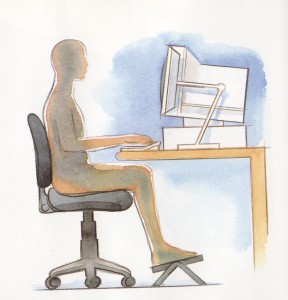Home office design is not just about being attractive. Home office set-up is not just about function. Home office productivity is about comfort, which means ergonomics. You can’t work at your best when you ache.
True or False? Ergonomics is complicated and expensive. FALSE
Chair, Keyboard and Monitor alignment are the 3 steps of Easy Ergonomics.
There are no silver bullets for good ergonomics and comfortable productivity. A $1500 desk chair or standing desk, by itself, is not the solution to back problems.

Three simple changes improve y9our comfort and productivity.
Starting from the ground up:
1. Chair
To prevent leg cramps and low back pain:
- Position your chair so your feet rest flat on the floor (if you are short you may need a foot rest),
- Your ankles, knees and hips should be at approximately 90º or right angles.
- The chair seat should be shallow enough for your feet to be flat on the floor while your back is supported.
- The chair seat should be deep enough to support your thighs without the front seat edge pressing into the back of your knees (a risk factor for deep vein thrombosis).
- A chair on wheels with a five-point base is the safest and most stable.
- Check for adequate firm cushioning. Click here to learn more about selecting the best desk chair for you.
And while you are adjusting your chair for optimum comfort, this is a good time to clear out the jumble underneath your desk and make room for your feet. ;-)
2. Keyboard
To avoid having your shoulders hunched while you work (a major source of muscle tension and pain):
- Adjust the height of your keyboard to a level that allows your shoulders to relax and your elbows bend at a 90º angle.
- For most people this means an articulating keyboard tray or adjustable keyboard stand. A keyboard drawer may not provide you with the adjustable height that fits you.
- If you work with a laptop, you may need a standard keyboard that you plug-in to your laptop.
- The keyboard tray should be wide enough to hold both your keyboard and your computer mouse and allow you to maneuver it easily.
3. Monitor or Laptop Screen
To avoid neck pain and headaches:
- Have your computer screen adjusted so your head is balanced on your shoulders and not thrust forward.
- Ergonomic engineers recommend the top of the computer screen be at eye-level when you are seated at your desk and looking straight ahead.
- This allows for a relaxed slightly downward gaze that is less fatiguing for your eyes and can minimize dry eyes.
- This means your computer screen should be 3-4 or more inches above your desk.
- Elevate your monitor or laptop screen using an adjustable stand or on a box, phone book or ream of paper.
- If you are short when seated or wear bi-focals, you may not need to elevate your computer screen.
- The screen itself should be about an arm’s length from where you are sitting.
- If you find yourself squinting or leaning forward or back to see better, you might want to use the often overlooked “zoom” function on your computer’s tool bar and adjust the font size to one that is easy to read. Learn more about easier reading from your computer screen.
- Avoid positioning your computer screen or keyboard at an angle from where you sit. Twisting in your chair to see your monitor a set up for back problems. Have your computer screen and keyboard aligned right in front of you.
This may take some trial and error adjustments. You may change the height of your chair and then need to modify the height of your monitor, but the results are well worth it: your back, neck shoulders and head will thank you.
What comfort challenges do you have when working? Have you discovered solutions? Please share in the comments below!
Learn more about ergonomics for the home office (a whole chapter) in The Smarter Home Office: 8 Simple Steps to Increase Your Income, Inspiration and Comfort.